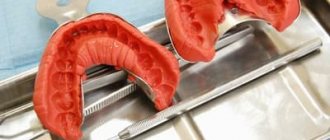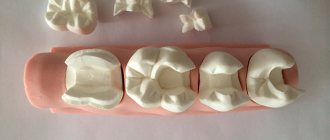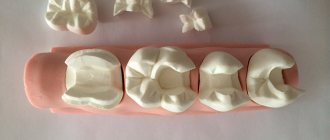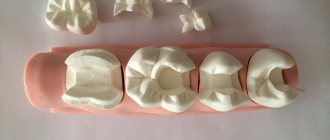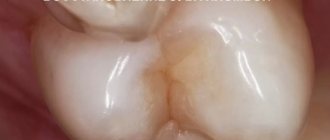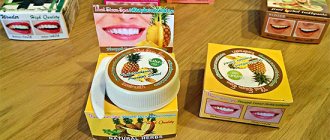If a tooth is destroyed by caries or as a result of injury, it must be restored, otherwise the tooth can be lost, and the absence of even one dental unit in a row is fraught with the most unpleasant consequences for health. For example, due to the absence of a tooth, an incorrect bite may develop, which leads to disruption of the correct process of chewing food and the development of various diseases of the digestive system.
If the tooth is slightly damaged, then most likely the doctor will use a regular, light-curing filling to restore it. But if the damage is significant, it would be more correct to use a stump tab.
Many people do not even know what kind of structure this is - a stump tab and for what purpose it is used by dentists. Meanwhile, the use of stump inlays makes it possible to successfully restore teeth that at first glance seem completely hopeless and must be removed.
In the article we will tell you in detail about what stump inlays are, what types of them exist, and why severely damaged teeth are best restored with inlays, and not with fillings and pins.
What is a stump tab and why is it needed?
A stump inlay is not a filling or a seal on a post. This is a specialized orthopedic design that is produced in a dental laboratory and is used to restore teeth that have been more than half destroyed by caries or trauma.
Of course, even a badly damaged tooth can be restored with a filling on a pin and then a prosthesis can be placed on it. But such an approach to prosthetics will be wrong, since large fillings, even if attached to pins, are simply not capable of holding well. The load on the tooth will sooner or later lead to the filling on the pin falling out along with the prosthesis, and then the tooth will have to be re-treated.
Stump inlays help to avoid such unpleasant consequences - they are firmly fixed in the root canal of the tooth and the dental crown is fixed on them. Externally, the inlays are very similar to stumps - ground teeth - hence their name.
Why are core inlays better than fillings and pins?
Fillings and pins are only applicable if the tooth has a sufficient amount of healthy tissue remaining. If only the root or thin walls of the tooth remain, then it cannot be restored with a pin, since such a restoration method will not be distinguished by either quality or reliability.
Firstly, under load, the pin can break and in the process damage the tooth root. Trauma to the root of a tooth is a direct indication for its removal; no methods for damaging the root system will help you save your tooth.
Secondly, dentures installed on large fillings and pins most often fall out some time after prosthetics. In this case, the treatment will have to be carried out again, and this implies new and significant financial costs.
IMPORTANT: Some dentists try to fix the fallen crown and pin with cement. But this is useless: the structure will not hold firmly, and in addition, an inflammatory process may begin under it, leading to rotting and destruction of the tooth.
Therefore, in case of severe tooth decay, only a stump inlay can provide high-quality and durable prosthetic results.
Inversion prosthetics method: restoration of the tooth stump and fixation of a metal-free crown
Highly aesthetic works from metal ceramics, press ceramics and frame ceramics on zirconium and aluminum oxide are a reality today. The skills and craftsmanship of the medical technician team create masterpieces that stun patients with their results. Today, aesthetic rehabilitation services can improve the patient’s personal status and sometimes change their fate.
But there is also a downside to this happiness: a chip of a fragment of ceramics, a chip of a veneer, a disintegration of an orthopedic crown, and sometimes even a defect in the tooth stump. Moments of happiness stop at this moment for our patient. The beloved restoration is no longer pleasing to the eye. The request to reuse a crown that has become cemented is most often the only request from the patient. It is not difficult to re-cement the crown with the remaining tooth stump. But the situation is completely different when decementation is accompanied by a defect in the tooth stump.
In this clinical case, I will show how to effectively and accurately carry out the inversion (reverse) prosthetics method.
Clinical case
Patient M., 35 years old, came to the clinic with complaints of decementing of an aluminum oxide crown by 2.1. Objectively: the crown had a movable position on the stump of tooth 2.1 and was removed without effort. A chipping of 1/3 of the tooth stump was noted (the inner part of the crown was filled with the separated fragment).
Defect of stump of 2.1 tooth
In the past, the tooth was subjected to endotherapy followed by restoration using a polymer pin. There was complete preservation of the polymer pin throughout. Only the inner surface of the crown with a fragment of core material broke off.
Recovery stages
Stage 1. Preparing the tooth core.
The surface of the tooth stump was slightly prepared in order to remove unreliable fragments of the composite stump material. After this, according to the adhesive protocol, the acid was applied for 15 seconds, rinsed off generously, the surface was left slightly moistened, and the adhesive system was applied. I used All Bond 3 adhesive (Bisco IL, USA). This is a universal dual-curing adhesive; it has a modified structure of the polymer matrix and is maximally stable on the dentin substance after polymerization due to its hydrophobicity. After preparation and polymerization, the dentin surface has a shiny appearance. This is good.
Prepared tooth stump for restoration
Stump restored with a crown
Stage 2. Crown preparation.
The inner surface of the crown is covered with insulating material. I used PRO-V COAT (Bisco IL, USA). This material creates a completely inert surface that prevents the fixation of any composite. In addition, it is highly washable and was originally intended to isolate the surface of the tooth structure from the temporary composite material in InLay & Overlay cases. But you can also use glycerin or water-soluble gel lubricant.
The crown is carefully removed from the restored tooth stump. This process may be accompanied by slight effort. The crown is very clearly fitted to the restored tooth stump. The use of release agents (in my case, PRO-V COAT) makes this procedure always predictable.
Stage 3. Fixation of the crown on the restored tooth stump.
Materials used for the adhesive fixation technique: All Bond 3 adhesive, primer for zirconium oxide, aluminum and metal Z-PRIMER PLUS, light-curing composite cement Choice 2
I use an adhesive bonded aluminum oxide crown. To do this, the inner surface of the aluminum oxide crown is sandblasted using aluminum oxide powder 50 microns at a pressure of up to 2 atm. at an oblique angle to the surface.
Degrease in alcohol or acetone and dry. A primer for zirconium oxide and aluminum Z-PRIMER PLUS (Bisco IL, USA) is applied to the inner surface of the crown for 30 seconds. Drying. The surface of the crown is ready.
The inner surface of the framework ceramics is treated with the primer Z-PRIMER PLUS (Bisco IL, USA)
The newly created tooth stump is subjected to an adhesive protocol: etched, All Bond 3 adhesive is applied, and polymerized. We add light-curing composite cement to the crown. The crown is adapted to the tooth stump. Excess cement undergoes 2-second polymerization, is removed from the edges of the crown, and transcoronal polymerization is performed on each side for 30 seconds.
Comments and clarifications:
- When working with metal-ceramics, I use chemical or dual-curing composites (Luxa-Core (DMG), Core-Flo, Bisfill 2B (Bisco)) as core materials.
- The surface of the tooth core when using chemical or dual-curing materials must be coated with adhesive systems compatible with such materials.
conclusions
Long-term clinical observations show the reliability and accuracy of the inversion prosthetics method. This technique can be successfully used in current clinical situations.
Types of stump inlays
Before installing a core inlay, it is imperative to treat the damaged tooth, remove all tissue damaged by caries, and also be sure to properly process and seal the root canals.
IMPORTANT: Root canal treatment is a process in which not the slightest mistake should be made! If the canals are treated poorly or improperly sealed, an inflammatory process may begin in them. In our dental clinic in Moscow - Firadent - treatment of tooth canals is carried out under a microscope, which allows the doctor to see the length and structural features of the canals and thus eliminate errors in the process of their treatment.
After treating the canals of the tooth, the orthopedic dentist begins to treat the patient: the specialist will unseal the canals to the length of the future stump inlay and take an impression for its manufacture. As we already wrote above, core inlays are produced in a dental laboratory.
There are several types of stump inlays. The classification of inlays is carried out according to the material of manufacture and the number of pins - fastenings with which the inlay will be firmly held in the tooth canals. The inlay may have several pins, their number is determined by the number of canals of the tooth being restored.
Based on the number of pins, the following types of stump inlays are distinguished:
- Single-rooted;
- Double-root collapsible and non-removable tabs;
- Three-root collapsible and non-removable stump inlays.
Multi-root inlays are most often made collapsible - this simplifies the process of securing the inlay in the tooth canals. But collapsible inlays are more expensive than non-demountable structures: the higher price is explained by the high complexity of manufacturing.
Materials for manufacturing pin stump inlays
Stump pin inlays can be made from different materials - ceramics or metal. Stump inlays with metal pins are most often made from an alloy of cobalt and chromium and are used for the installation of metal or metal-ceramic prostheses.
Cobalt-chrome core inlays have a number of specific advantages:
- They have good biocompatibility with human body tissues;
- Stump pin inlays made of this metal alloy fit quite tightly to natural tissues and therefore, when used, the risks of caries, inflammatory processes and further tooth destruction are reduced;
- Cobalt-chrome alloy has high strength and therefore a crown installed on a pin insert made of this material will not shrink during operation.
Stump inlays made of cobalt-chrome alloy allow for proper distribution of the chewing load, which reduces the risk of cracks and tooth destruction. The advantages of inlays made from this material include their affordable cost.
Ceramic pin inlays are used for the installation of metal-free dentures. This allows you to obtain impeccable aesthetics of the restored tooth. If you place a metal stump insert under the ceramic structure, it can be quite noticeable and, of course, it will spoil the appearance of the restored tooth. Therefore, only ceramic pin inlays are placed under ceramics.
How stump inlays are made: an overview of the main stages
Stump inlays are made individually for each patient. Treatment begins with an examination of the patient and consultation with two specialists – a general dentist and an orthopedic dentist.
Before an impression is taken from the tooth, according to which a stump insert will be made, high-quality sanitation of the oral cavity is carried out, and all diseases of the teeth and gums diagnosed during the examination are treated. The damaged tooth is treated: the nerve (pulp) is removed from it, and the canals are filled. This is where the work of the dentist-therapist ends and the orthopedist begins to care for the patient.
Further treatment will proceed according to the following scheme:
- The prosthetist will correctly prepare the tooth for installation of the stump inlay and select its type.
- When choosing the type of stump tab, the material of its manufacture and the type of tab (single-root or multi-root, cast or collapsible stump tab) are determined.
- Then the doctor will make an impression of the patient’s jaws, which will be sent to the dental laboratory, where a stump inlay will be made from the impression taken.
- Based on the impression, a model of the stump inlay is first made, and then a permanent structure is made from the selected material.
- The dental technician passes the finished stump inlay to the orthopedist.
After the stump inlay is ready, the patient is invited to the prosthetist’s office and the doctor installs the stump inlay in the tooth canals. A temporary prosthesis is put on the tab and a break is taken in the treatment until the crown is made, which the doctor fixes on the stump tab.
Composite vs ceramic
Composite is most often used in cases of direct restoration of teeth with filling material. With the indirect restoration method, the main material is ceramic, which has great strength and flexibility during installation. In addition, ceramics are resistant to stress and do not wear out for a long time.
The big advantage of the composite is its relatively low price, thanks to which even non-rich people can restore teeth.
Direct and indirect composites
Composite materials used in dentistry can be used in two versions.
Direct composites for teeth - the procedure for their manufacture and installation takes place directly in the patient’s oral cavity. In this way, dental gaps are restored and gaps between teeth are filled.
The indirect method involves the production and hardening of the material outside the oral cavity. Moreover, such materials have greater strength, so they are used in the following situations:
- For the manufacture of composite overlays;
- To restore interdental spaces;
- Restoring the integrity of teeth;
- Making crowns.
Composite crowns
The disadvantages of such products are their fragility, therefore they require regular replacement or correction. Dentists use composite crowns to cover the entire tooth.
Indications for use:
- Impossibility of installing metal-ceramic crowns;
- Temporary crowns.
Metal composite bridges
Composite bridges have a special shell that contains the composite. A type of composite bridge involves installing the product on one or more teeth. Thus, an adhesive bridge is more often used, which involves installation on one tooth. Used when the patient does not have normally developed bone tissue for implantation. The procedure has a lower cost than other restoration methods.
Recovery procedure
The procedure for tooth restoration with a composite includes the following steps:
- Anesthesia;
- Preparation of the oral cavity - includes sanitation of the oral cavity and removal of old fillings, cleaning the site where the composite was introduced, selecting a shade and insulating the tooth;
- Direct restoration using bonding techniques and the use of a binder component.
After complete composite restoration of teeth, final finishing and polishing of the tooth surface, bite testing and additional whitening occur. Restoration of the front teeth with filling material is also used.
Advantages and disadvantages of using stump inlays
The main advantage of stump pin inlays is the high reliability and durability of prosthetics. This design will firmly hold the installed dental prosthesis and, moreover, will allow for proper distribution of the chewing load. When using pin stump inlays, the risk of crown loss is reduced to zero.
Installing crowns on the stump inlay and pin allows you to increase the useful life of the prosthesis. In addition, core inlays help to obtain the ideal tooth shape and are suitable for restoration of anterior and chewing teeth.
There are only two disadvantages to the use of stump inlays - higher price and longer prosthetic time. On average, it takes about 2 weeks to make an inlay.
IMPORTANT: Only an experienced prosthetist can make a high-quality multi-root collapsible stump inlay. Therefore, it is so important to choose a clinic for your treatment that employs competent and qualified orthopedists and dental technicians and has its own, well-equipped dental laboratory. Our dentistry in Moscow, Firadent, 100% meets these conditions: your treatment with us will be carried out with impeccable quality and comfort!
Manufacturing and installation stages
First, prepare the tooth:
- remove damaged dental tissue;
- root canals are filled;
- unseal the canal to a third or half the length;
- prepare the tooth;
- make an impression of the jaws (usually silicone A is used for this);
- cover the tooth with a temporary filling.
The impression is then sent to a laboratory where the inlay is modeled (using a computer) and cast.
Patients are interested in how long it takes to make a stump inlay. This process will take at least five days.
How to place a stump tab?
Dental prosthetics with inlays consists of several stages:
- a temporary filling is removed from the tooth;
- wipe the insert with alcohol to degrease;
- the tooth is treated with an antiseptic;
- An inlay is placed into the tooth cavity and fixed with special cement (thanks to the cement, the inlay fits tightly to the tooth, which prevents the formation of cracks);
- a crown is installed on the stump tab.
Are there any contraindications to the use of stump pins?
Unfortunately, not in all cases, stump pin inlays can be used for dental prosthetics.
Stump inlays should not be used under the following circumstances:
- When a tooth is destroyed below the gum level;
- When the quality of root canal filling is poor. In this case, it is necessary to unseal the canals, reprocess and seal them, and only then install a pin stump inlay and crown;
- A contraindication to the use of a pin stump insert would be an inflammatory process in the area of the tooth root;
- Allergy to the materials used to make the stump inlay on the pin.
Also, inlays are not placed on loose and mobile teeth.
IMPORTANT: In some cases, a stump pin can still be installed even if the tooth is destroyed below the gum level. But this will first require an additional operation - an osteotomy. The essence of this operation is to cut down the bone tissue to such an extent that the gum is below the destroyed tooth.
Dental care after the installation of a core tab
Stump inlays do not require complex specific care. All you need to do is maintain oral hygiene, brush your teeth regularly and undergo periodic dental examinations and professional hygiene procedures.
To clean crowns installed on teeth with core inlays, it is best to use brushes with soft bristles; it will also be useful to rinse your mouth after each meal - with a special balm or just clean water. When brushing your teeth, it is important to clean them from all sides and be sure to thoroughly clean the interdental spaces. For this purpose, special brushes and dental floss are used.
Prices for stump inlays
How much does a stump tab cost? Prices for stump inlays can vary greatly: the main influence on the cost of the structure will be exerted by the material of its manufacture. The most budget option is metal stump inlays. A simple non-removable (cast) metal stump inlay costs about 5,000 rubles. A collapsible multi-root metal stump inlay will cost a little more - from 6,000 rubles and more.
Ceramic and zirconium stump inlays have the highest prices. Their cost starts from 8,000 rubles.
IMPORTANT: The cost of making a core tab does not include the cost of installing a crown! Dental treatment, canal filling, production and installation of a crown are paid separately!
Material for making a tooth core
Artificial dental inlays are made from metal - an alloy of nickel and chromium, which is highly resistant to corrosion and does not cause allergic reactions. Removable clasp dentures have a frame made of the same material.
Inlays are made in the laboratory by casting. The structure can consist of one element (monolithic) or be a prefabricated structure (when it comes to a multi-channel tooth). Due to the location of the dental canals at an angle to each other, it is difficult to place a monolithic inlay in such a tooth. Therefore, one or two roots are placed at once, and the third and fourth are added later. Then the entire structure is united by a common stump.
When making prosthetics for teeth located in the smile zone, it is important to follow the rule: a crown made of the same material that was used for the artificial stump is placed on the inlay. Otherwise the result will be unsuccessful.
Typically, crowns for the front teeth are made of ceramic. Therefore, it is advisable to use a ceramic inlay. After all, a metal product will be visible through the walls of the prosthesis. The tooth will acquire a bluish tint.
Here it is also worth paying attention to the fact that ceramics obtained by pressing are not particularly durable, which means it is better to make an inlay from zirconium. It is much stronger, while having all the external properties of ceramics.
Zirconium inlays are more expensive, but as a result of their use, the patient receives a firmly fixed artificial tooth, which is difficult to distinguish from the real one.
What to choose when doing prosthetics - restoring a tooth with a core tab or a filling?
What to choose when installing a crown - restoring a tooth with a core inlay or a filling? This question is often asked to doctors by patients who decide to restore their teeth. This question can be answered this way: if your tooth is badly damaged, and you want the installed crown to serve you for as long as possible, it is better to choose not a filling, but a stump inlay.
Yes, prosthetics with a stump inlay will be more expensive than installing a crown on a regular filling, but all costs will be repaid by the long useful life of the prosthesis and the high quality of the prosthetics. Stump inlays allow you to save and successfully restore even the most hopeless teeth!
If you still have questions about stump inlays, you want to find out their exact cost and find out the possibility of using a stump inlay in your case - come to an appointment with specialists at our dental clinic in Moscow - “Firadent”! We will be happy to help you achieve a new beautiful smile with healthy teeth!
Modern principles of post-endodontic dental restoration
A. Lavrov
chief physician of the Organicdent clinic (Moscow)
In the clinic of modern orthopedic dentistry, non-removable denture designs are most common. Despite this, the need for the use of crowns and bridges remains very high (Lebedenko I. Yu. et al., 2001, Goryunov V. V. et al., 2001, Zhulev E. N., 2005).
The production of all-ceramic and cast orthopedic structures is preceded by a whole chain of clinical and laboratory stages.
One of the most important stages that determine the subsequent success or failure of the entire treatment is post-endodontic restoration of teeth and odontopreparation.
Dental preparation is an inevitable operation in the manufacture of fixed dentures; in many cases, this operation is not harmless to the supporting tooth and the body as a whole. However, the quality of tooth preparation is of greater importance and often determines the effectiveness of orthopedic treatment. Of no small importance in odontopreparation is the correct choice of method for restoring the tooth stump after endodontic treatment.
The large selection of different techniques, pins, cements for fixation and materials for restoring tooth stumps that have appeared in recent years has made it possible to significantly expand, speed up and simplify the procedure for restoring destroyed hard tissues before prosthetics, but such a variety can confuse even an experienced clinician. To date, the issues of choosing the optimal method and stages of restoration have not been resolved, as a result of which a stump is formed that provides retention of fixed structures and long-term functional and aesthetic results, depending on the fixing material.
The nature of the tooth preparation in the area of the ledge determines the marginal fit and resistance to the carious process of the artificial crown. The aspects of finishing the tooth stump and the question of what characteristics the surface of the stump should have in its various areas to ensure the highest quality set of aesthetic and functional characteristics remain insufficiently illuminated.
Another important aspect is the comparison of the properties of materials and methods for restoring a tooth stump with composite materials.
Thus, the problem of comparative assessment of various factors that determine the set of optimal characteristics of materials for restoring a tooth stump, such as, for example, the strength and reliability of the pin system in combination with composite cement and core material, etc., remains relevant.
The nature of the tooth preparation in the area of the ledge determines the marginal fit and resistance to the carious process of the artificial crown. In this publication, we will look at modern principles of restoration of teeth previously treated for complicated caries in the Endo-Resto concept proposed by DentsplySirona based on the Core & Post material, which is the most unified and universal set for post-endodontic restoration on the market.
Often, specialists are faced with various dogmas and even scholasticism associated with various methods for restoring a destroyed tooth stump. Let's try to understand the principles and features of tooth stump restoration after endodontic treatment.
The basis of the tooth stump for any non-removable orthopedic structure is not a cast stump inlay or even a pin with fixing material, but a tooth or tooth root. This principle has been taken as a basis for the last 50 years; back in the works of Sorensen & Martinoff in 1984, the connection between resistance to tooth root destruction and the amount of lost tissue was shown. In later studies (Helfer, Melnik, Shilder, 1972; Carter, Sorensen, 1983; Rivera, Yamauchi, 1993) it was believed that after depulpation, teeth are destroyed due to dehydration. However, already in 1995, Messer, Raitvisai proved that overhanging edges of enamel and cusps without dentin support break off in an equal number of cases in vital and non-vital teeth, which casts doubt on the previously stated hypothesis. Around the same time, Randow, Nathanson, Shilder (1991) found that the key factor in resistance was not dehydration, but the volume and location of lost tissue. And already in our century, researchers from the USA firmly introduced the concept of the Ferule effect - the rim effect. It consists in the ability to grasp part of the tooth around the circumference. The greater the height of the tooth walls under the crown, the better the long-term prognosis and ability to resist fractures.
The basis of the tooth stump for any non-removable orthopedic structure is not a cast stump inlay or even a pin with fixing material, but a tooth or tooth root. What is the secret to the longevity of a fixed orthopedic structure? Sorensen, Engelman, Isador, Brondum in 1999, Stankiewicz, Wilson in 2000, Cheng, Chean in 2004. continued to study the biomechanics of pulpless teeth. And in 2010, this question was answered - with the publication of an article written by David Clark, John Khademi (2010), who for the first time outlined the concept of 3D FERRULE, or the importance of not only the height of the remaining tooth stump under the crown, but also the thickness of the wall from the mouth canal to the edge of the root.
Today, when cone beam tomography has become an integral part of routine practice, we have been able to look inside the tooth structure and, most importantly, examine the canal system before and after treatment and restoration using various techniques. Researchers did the same. And now Hagay Shemesh from ACTA Amsterdam University in 2011 reports that root fractures after endodontic treatment are most often the result of the use of aggressive conical nickel-titanium instruments.
The conclusions of the study were based on the results of photospectrometric analysis of tooth root samples before and after endodontic treatment. However, already in 2015 and 2016. De-Deus from Brazil refutes the version of the previous researcher based on data from cone-beam tomography of teeth before and after endodontic treatment, which leaves us in no doubt that the causes of tooth root fractures are undoubtedly polyetiological.
In the 21st century, the concept of the ferule effect was introduced - the rim effect. It consists in the ability to grasp part of the tooth around the circumference. Researchers in recent years have found that if you have 2 or more mm of tooth stump height remaining above the gum level, the method and material of stump restoration play a secondary role. It is important to understand that pins and various types of core inlays do not strengthen the tooth, but only help to hold the artificial core and crown on it.
In 2012, the author of the article, together with researchers from the University of Guarulhos (São Paulo, Brazil), conducted a study comparing different combinations of cements and fiberglass posts in in vitro restoration of tooth core. And they found that the Core & Post automatic cement mixing technique demonstrated the best results in fixing the fiberglass post in the canal compared to other dual-cure cements.
This technique of mixing and introducing cement into the root canal gives more reliable results in terms of the homogeneity of the cement mixture, the usefulness of the properties of the materials and the reliability of application. The Core & Post kit provides the optimal combination of materials and instruments for most post-endodontic dental restorations . The results of the study were published in the journal of the Brazilian Dental Association, Brazilian Oral Research Volume 27 September 2013.
Thus, as a result of an analysis of the literature and our own experience, we can conclude that in addition to traditional cast core structures, adhesive systems reinforced with fiberglass pins are widely used, as they are the most minimally invasive in relation to the structures of hard dental tissues.
Adhesive structures reinforced with pins should be used as an alternative to cast ones in cases where the tooth walls are kept higher than 2 mm from the gum level.
The use of various combinations of pre- and post-endodontic restoration can speed up the rehabilitation process of patients and allows treatment to be carried out with greater comfort and with a higher aesthetic result.
Adhesive structures with pins should be used as an alternative to cast ones in cases where the tooth walls are kept higher than 2 mm from the gum level
The main factors determining the successful prognosis of restoration are high-quality endodontic treatment, careful treatment of the remaining tooth structures and compliance with the manufacturer’s recommendations in the manufacture and fixation of various post-endodontic dental restoration systems.
